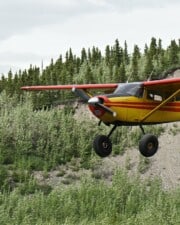Everyone knows that pilots speak a language all their own, full of jargon and acronyms for everything. Weather reports are one of the worst offenders. Many of these codes and abbreviations are holdouts from the days of faxed text-only weather reports between air traffic controllers and forecasters.
A SIGMET is a weather report of hazardous weather for aircraft. In its raw form, it is abbreviated text. But SIGMETs are often also displayed with boxes drawn on charts, much like storm watches or warnings might be shown on the evening news.
What is a SIGMET and AIRMET?
SIGMETs and AIRMETs are different types of weather reports issued for pilots. Like many weather products, they are internationally standardized with set formats and abbreviations.
SIGMETs are only issued under very specific circumstances and generally last four hours.
SIGMET vs AIRMET
SIGMETs and AIRMETs are text weather reports indicating a weather hazard. SIGMETs are worse than AIRMETs, meaning they are for more severe conditions.

It’s sometimes generalized that AIRMETs are for small aircraft, and SIGMETs are for everyone–small and large aircraft, regardless of their size.
This is misleading, however. While larger aircraft and commercial operators might be able to deal with the conditions listed in an AIRMET, the pilot always needs to know about them. Each aircraft and each pilot has individual limitations, and the difference between AIRMET and SIGMET has nothing to do with that.
What Does SIGMET Stand For?
SIGMET is short for Significant Meteorological Information. AIRMET, on the other hand, stands for Airmen’s Meteorological Information.
Can an Airplane Take Off in a SIGMET?
So, can an aircraft still operate if a SIGMET is issued?
No hard-and-fast rule says a pilot cannot operate inside a SIGMET. Weather information is based on observations and reports, but the final authority to operate an aircraft falls on the pilot in command.
In other words, it’s possible that a SIGMET might indicate conditions that do not affect the immediate area or the specific operation that a specific flight will encounter.
Flying in the area of a SIGMET without any knowledge of the weather event or dangerous conditions would be irresponsible. But if the pilot is fully aware of the conditions and believes that the risk level is acceptable, no rule prevents them from flying.
Types of SIGMETs – What is a SIGMET Issued For?
There are two types of SIGMETS, regular and convective. All of them are only issued if specific weather phenomena are observed.
Most text SIGMETs will also include a forecast indicating if future issuances are expected. While these don’t indicate that conditions currently warrant a SIGMET, they’re important for a pilot to understand that a SIGMET might be coming.
SIGMETs are issued when the following weather conditions are widespread, meaning they cover more than 3,000 square miles. Here are the things that would warrant a SIGMET.
- Severe icing conditions not associated with thunderstorms (SEV ICE)
- Severe turbulence not associated with thunderstorms (SEV TURB)
- Duststorms or sandstorms that lower the visibility to less than three miles (IFR conditions) (WDSPR DS, WDSPR SS)
- Volcanic ash (VA)

What is Convective SIGMET?
Convective SIGMETs are issued for widespread areas of or severe convective activity–AKA thunderstorms. But not every thunderstorm gets a Convective SIGMET because an individual storm cell could easily be spotted and avoided by an aircraft.
The existence of a Convective SIGMET means that are thunderstorms, and that implies all the things that come with them. Many of these are hazardous to all operators, including severe turbulence, severe icing, and low-level wind shear.
Convective SIGMETs are issued for thunderstorms that pose a bigger threat or one that is hard to avoid. These include:
- Embedded thunderstorms (dangerous storms hidden inside other clouds)
- A line of thunderstorms
- Widespread thunderstorms covering more than 40 percent of a 3,000 square mile area
- Surface winds greater than 50 knots
- Hail greater than 3/4-inch
- Tornadoes
SIGMET Examples
Here’s a look at a real-life SIGMET issued by the Canadian Weather Office for Vancouver Center (CZVR).
WSCN01 CWAO 061525
CZVR
CZVR SIGMET A1 VALID 061525/061925 CWEG-
CZVR VANCOUVER FIR SEV TURB OBS WI 50NM WID LINE BTN N5440 W13035 – N5231 W12828 – N4951 W12758 SFC/FL030 STNR INTSF=
SIGMET Abbreviations
While it’s not hard to read the SIGMET above, it’s full of abbreviations. Reading them requires a little knowledge about ICAO location and airport codes frequently used in aviation. It’s always easier if you’re familiar with the area you’re looking at.
WS — SIGMET
CN — Canada
01 — First SIGMET issued for the day
CWAO — Originating facility, Canadian Weather Office, Montreal
061525 — Day of the month, time of issue “6th at 1525 Zulu time”
CZVR — Air Route Traffic Control Center location (Vancouver Center)
VALID 061525/061925 — Valid times “6th at 1525 to 1925 Zulu time”
CWEG-CZVR VANCOUVER FIR — Areas affected “CWEG Alberta Center, CZVR Vancouver Center, Vancouver Flight Information Region (FIR)”
SEV TURB OBS — Conditions “severe turbulence observed”
WI 50NM WID LINE BTN N5440 W13035 – N5231 W12828- N4951 W12758 — Specific location, “within a line between these three points”
SFC/FL030 — Altitudes “surface to Flight Level 030 (3,000 feet)”
STNR — Movement “stationary”
INTSF — Intensity change expected “Intensifying”
What is Included in a SIGMET?
The example above shows the parts of a SIGMET you could expect to see, although each one will be customized to say what it needs to say.
- Header information, including issue time
- Valid times
- Region affected
- Type of hazardous conditions
- Boundary of the affected area
- Altitudes affected
- Movement of weather
- Intensity change
Convective SIGMET Example
Here’s a real-world example of a Convective SIGMET, along with what it all means.
WSUS31 KKCI 061555
SIGE
CONVECTIVE SIGMET 10E
VALID UNTIL 1755Z
MA RI NJ NY CSTL WTRS
FROM 60SSW ACK-140SSE HTO-130ESE SIE-50S HTO-60SSW ACK
AREA EMBD TS MOV FROM 25030KT. TOPS TO FL290.
WSUS31 KKCI 061555 — SIGMET US Number 31 issued by KKCI (Aviation Weather Kansas City) on the 6th at 1555 Zulu
SIGE — SIGMETs Eastern US
CONVECTIVE SIGMET 10E — Number 10 in the Easter US zone
VALID UNTIL 1755Z
MA RI NJ NY CSTL WTRS — Affected regions include Massachusetts (MA), Rhode Island (RI), New Jersey (NJ), and New York (NY) coastal waters
FROM 60SSW ACK-140SSE HTO-130ESE SIE-50S HTO-60SSW ACK — The location of the storms, with a box drawn between VORs {From 60 nautical miles south-southwest of Nantucket (ACK), to 140 nm SSE of East Hampton (HTO), to 130 nm ESE of Sea Isle, NJ (SIE), to 50 nm S of East Hampton, and back to 60 nm SSW of Nantucket}
AREA EMBD TS MOV FROM 25030KT. TOPS TO FL290. — An area of embedded thunderstorms is moving from 250 degrees at 30 knots. Tops of the storms go up to Flight Level 290 (29,000 feet)

Where Do Pilots Get SIGMET Information?
SIGMETs are important, so it should be no surprise that they are published and broadcast in as many places as possible.
Before a flight, checking for active SIGMETs and AIRMETs is vital to any preflight weather briefing. If talking to a briefer, it will be one of the first things they mention.
These weather warnings are also published on many websites and apps. For example, Foreflight will draw the SIGMET boundaries on the chart and display the text inside the briefing tools. AviationWeather.gov, one of the best places to get informal weather briefings, will display the hazardous areas on a map or show you the original text.
During a flight, SIGMETs are broadcast by air traffic control facilities. When issued, every controller in the area will make an announcement. They will also be added to ATIS broadcasts. The pilot can then hear the full SIGMET by contacting a Flight Service Station.
SIGMETs may also appear on the MFD (Multifunction Display) right in the cockpit of planes with in-flight weather connections via satellite.
If you want to learn everything there is to know about aviation weather products, including all of the abbreviations used, be sure to download the FAA’s Aviation Weather Handbook.
Related Posts













